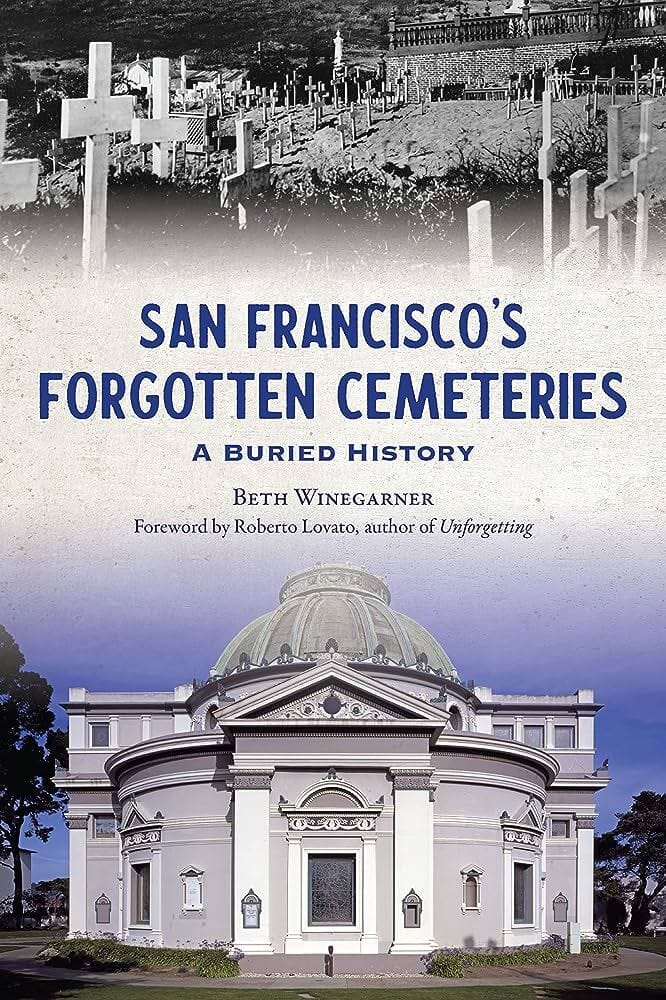
From Beth Winegarner: You’re looking at Sen. David Broderick’s monument (the pointy one in the far distance) in Laurel Hill Cemetery, near where the Trader Joe’s on Masonic Avenue is today. In the foreground is Calvary Cemetery, on the slopes of Lone Mountain. Credit: Lawrence & Houseworth, publisher, Library of Congress.
San Francisco’s Forgotten Cemeteries, A Buried History by Beth Winegarner is the historical account of one city’s failure to their dead. As a kid growing up in San Francisco, I remember hearing various stories from my grandparents about the cemeteries and their demises. Bodies being moved from one end to the next, only to be moved again a second or third time. Families were informed that only the headstones would be moved at one point, and the cost of moving a loved one’s body would be put on the family. Otherwise, they could expect to have the city seal their fate with cement.
With a sweet dedication to the forgotten dead of San Francisco, Winegarner transports us from one century to the next with fascinating details of the city’s death industry. The Mission Dolores Cemetery, though standing still to this day, has gone through renovations, disrupting the dead and their living loved ones. A truly disheartening and discouraging story unfolds and becomes a central theme in this text. We failed our dead. Winegarner takes particular notice of the ways in which racism and classism impacted not only the living but the dearly departed as well. The systems that existed within the city appeared to actively work against those who could not afford relocation fees. Winegarner takes no issue with pointing these flaws out.

You can nab a copy of the book right here.
As I made my way through San Francisco by way of cemetery after cemetery in Winegarner’s book, I thought of a recent cemetery excursion I had myself. My great-grandmother and great-great-grandmother are both buried in Vacaville, having immigrated here from Spain in the late 1800’s. During a trip to the Bay Area I decided it was time to pay a visit to the cemetery, and meet them, for the first time. With my wife and son fully onboard, we obtained a map from the lovely cemetery manager, who was able to give us a general idea of where they both were located. My great-great-grandmother, Prudencia Grima Ramos was easily found with her large granite headstone, immaculately engraved with religious memorabilia. However, my great-grandmother, Maria Grima Martin, was much more difficult as she was buried in an area called ‘the old part’, with hardly noticeable markings. The caretaker of the cemetery eventually joined us on our hunt, though we were left disappointed after over an hour of searching. My heart hurt. I refused to leave until we succeeded. Maria Martin died just days after giving birth to my grandmother, who raised me in San Francisco. She is 94 today, and we are closer than we’ve ever been. I had to find her mother, who she never met. Whose grave she was never able to find herself. As I wandered aimlessly, sweating profusely, a call for my name came. The caretaker had found her. She was right in front of where I had parked my car. A sign of connection? I’d like to believe so.
Local Journalism for Working stiffs
We write for the poets, busboys, and bartenders. We cover workers, not ‘tech’, not the shiny ‘forbes 100 bullshit’. We write about the business on your corner and the beer in your hand. Join the Bay's best newsletter.
I share all this to say that if I had not been able to locate her, a feeling of true disconnect and sadness would have surely filled me. To not be able to find a loved one seems criminal. In a sense, that is the moral of this story that Winegarner brilliantly lays out for us. So many descendants have no way of finding and connecting with their past, their loved ones, their families. That is in the hands of the city. Everyone has a right to proper burial, and everyone has a right to be found, even if it is centuries later.
San Francisco’s Forgotten Cemeteries, A Buried History was released on August 28, 2023. Check out Beth’s website for upcoming book events and grab yourself a copy of this fabulous book right here.
The post San Francisco’s Forgotten Cemeteries: How One City Failed Their Dead appeared first on Broke-Ass Stuart's Website.









